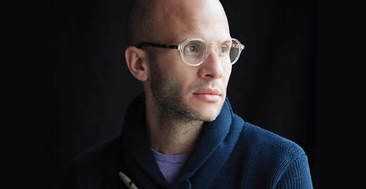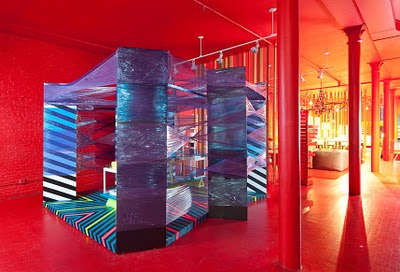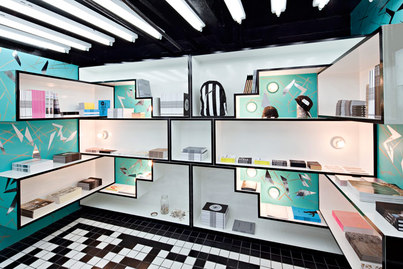Arresting Design

The seriously dangerous dazzle of Rafael de Cárdenas
In Toronto, Jan 2014
Story by Gordon Bowness
The term postmodernism immediately conjures up kitsch nightmares from the 1980s: Greco-Roman-Victorian temple granaries, garish colours and conspicuous consumption—Mississauga Civic Centre, Peter Shire teapots and American Psycho, to be exact.
In the design world, few admit to being a postmodernist anymore. Even Rafael de Cárdenas shies away from the term, though he wholeheartedly embraces the era that gave birth to the movement.
De Cárdenas, a keynote speaker at the Interior Design Show in Toronto this month, is an emerging design powerhouse with a long list of high-end commercial clients, like Baccarat, Nike and Nordstrom, and a growing number of well-heeled private homes. He’s also done a line of furniture for the Johnson Trading Gallery, a shoe for Rivieras, and a new series of house wares for Guillaume out later this year. Architectural Digest just put him on their 2014 top 100 list of architects and interior designers.
De Cárdenas’s designs often feature op-art-like stripes of black and white, off-kilter geometries and high-gloss surfaces in eye-popping colours—a brash exuberance that harkens back to postmodernism’s heyday. Just don’t call it postmodernism.
“I’m not living in a postmodernist era,” says the 39-year-old New Yorker. “So I can’t see myself as a postmodernist.” But de Cárdenas does admit his passion for postmodern design: Memphis furniture, Phillipe Starck objects and, oddly enough, the Shelley Long film Troop Beverly Hills.
“I’m pretty obsessed with the ’80s, because they referenced extremity in form and culture in a way that previous eras didn’t. It’s something we hadn’t seen probably since neoclassicism, or even far before that.”
De Cárdenas’s midtown apartment houses a collection of Memphis furniture, pieces by Ettore Sottsass and Michele De Lucchi, irreverent Italians who exploded onto the scene in 1981. The Memphis group thumbed their noses at the prevailing modernist distaste for decoration, colour and irony. Form didn’t have to follow function; objects could just be pretty. It’s that gap between what an object does and how it looks that Cárdenas loves to exploit.
“One of the first things I can remember being drawn to is a Philippe Starck juicer. I was eight or nine and remember thinking it was such an unusual thing, pretty ingenious. Probably the first time I thought about something looking like it did not need to, to do what it was meant to.”
De Cárdenas, named to the Out 100 list in 2012, is also attracted to the Memphis group’s anarchic, rebellious spirit. He, too, wants to push against the expected and accepted. Other favourites he cites include American designers Dorothy Draper and Tony Duquette. “At a time when modernism was proliferating, they were kind of going against it with their florals and, I don’t know… a simplified, garish, clumsy version of a Queen Anne leg, and things like that. They were doing something weird for the time. It was not normal and yet it was very fashionable.
“In a weird way you can kind of see how Philippe Starck and Tony Duquette are similar. They were doing the same thing at different times.”
In Toronto, Jan 2014
Story by Gordon Bowness
The term postmodernism immediately conjures up kitsch nightmares from the 1980s: Greco-Roman-Victorian temple granaries, garish colours and conspicuous consumption—Mississauga Civic Centre, Peter Shire teapots and American Psycho, to be exact.
In the design world, few admit to being a postmodernist anymore. Even Rafael de Cárdenas shies away from the term, though he wholeheartedly embraces the era that gave birth to the movement.
De Cárdenas, a keynote speaker at the Interior Design Show in Toronto this month, is an emerging design powerhouse with a long list of high-end commercial clients, like Baccarat, Nike and Nordstrom, and a growing number of well-heeled private homes. He’s also done a line of furniture for the Johnson Trading Gallery, a shoe for Rivieras, and a new series of house wares for Guillaume out later this year. Architectural Digest just put him on their 2014 top 100 list of architects and interior designers.
De Cárdenas’s designs often feature op-art-like stripes of black and white, off-kilter geometries and high-gloss surfaces in eye-popping colours—a brash exuberance that harkens back to postmodernism’s heyday. Just don’t call it postmodernism.
“I’m not living in a postmodernist era,” says the 39-year-old New Yorker. “So I can’t see myself as a postmodernist.” But de Cárdenas does admit his passion for postmodern design: Memphis furniture, Phillipe Starck objects and, oddly enough, the Shelley Long film Troop Beverly Hills.
“I’m pretty obsessed with the ’80s, because they referenced extremity in form and culture in a way that previous eras didn’t. It’s something we hadn’t seen probably since neoclassicism, or even far before that.”
De Cárdenas’s midtown apartment houses a collection of Memphis furniture, pieces by Ettore Sottsass and Michele De Lucchi, irreverent Italians who exploded onto the scene in 1981. The Memphis group thumbed their noses at the prevailing modernist distaste for decoration, colour and irony. Form didn’t have to follow function; objects could just be pretty. It’s that gap between what an object does and how it looks that Cárdenas loves to exploit.
“One of the first things I can remember being drawn to is a Philippe Starck juicer. I was eight or nine and remember thinking it was such an unusual thing, pretty ingenious. Probably the first time I thought about something looking like it did not need to, to do what it was meant to.”
De Cárdenas, named to the Out 100 list in 2012, is also attracted to the Memphis group’s anarchic, rebellious spirit. He, too, wants to push against the expected and accepted. Other favourites he cites include American designers Dorothy Draper and Tony Duquette. “At a time when modernism was proliferating, they were kind of going against it with their florals and, I don’t know… a simplified, garish, clumsy version of a Queen Anne leg, and things like that. They were doing something weird for the time. It was not normal and yet it was very fashionable.
“In a weird way you can kind of see how Philippe Starck and Tony Duquette are similar. They were doing the same thing at different times.”
|
Labels don’t stick in a post-postmodern world. But one overarching idea prevails in de Cárdenas’s designs: stopping viewers in their tracks. “The aim is to create some sort of dazzling confusion,” he says. “That is interesting to me, [an environment] that is immersive and yet to some degree extracts the observer for at least a few moments. Something’s jarring them, something’s different, and they have to face it.”
Even in his more restrained work, like the Baccarat stores and many of the residential projects, de Cárdenas says there has to be some extreme element, “whether that be one point of colour or an angle… something that seems a little bit dangerous. “To me, that’s an interesting feeling, to express this little terror.” The desire to express something unsettling first propelled de Cárdenas towards art and painting. “I didn’t have an interest in architecture,” he says. “I don’t really have an interest in architecture now, to be honest. I was always really inspired by fashion. I like street culture, I like music, I like art. And I like the speed at which those things move. How palpable they are, [how] they are part of day to day life.” While studying art and fashion at the Rhode Island School of Design, he was recruited by Calvin Klein. He quickly rose through the ranks and was promoted to full designer in the men’s collection studio. But he left Calvin Klein after three years to study architecture. He fully intended to return to fashion. His main sources of inspiration at the time were avant-garde designers like Bernadette Corporation, a NYC |
art collective that designed a women’s line in the mid-1990s, and British designers Alexander McQueen and Tristan Webber. “There were all these young designers who were playing with the notion of the show,” says de Cárdenas.
But architecture grabbed hold of him while studying at UCLA. “I drank the Kool-Aid,” he says. After getting his masters he worked with Greg Lynn, the influential architect and professor who popularized non-linear biomorphic designs (blob architecture). But de Cárdenas says he grew frustrated with the academic, theoretical nature of Lynn’s Form studio; he needed to make actual things. So he opened his own design firm in 2005, Architecture at Large.
“There I was, late 20s early 30s, figuring out what I’m going to do, playing around with stuff, begging people to let me do projects. And some of those people I was begging were friends, who were the same age as me. And they were like, ‘I’m opening a store and I have $5,000 for interior design.’ So we used what we had, or we’d make it ourselves.” Hence his early reliance on paint and other surface applications, like the stripes. To the modernist’s “less is more,” de Cárdenas responded by making more with less.
“It was important to me that everything I design exists. I want to participate with people. I want people to get the feel and the look of [my design] and what it means.”
For his appearance on the Saturday of IDS de Cárdenas plans to give a lecture called “Ornament and Crime: Criminal Intent,” a title referencing the early modernist Adolf Loos. De Cárdenas wants to discuss how design must open up a space for creativity. “The lecture is about how cities have become too safe and clean for the production of culture. Great artists don’t live in New York anymore because they can’t afford it.”
Like the postmodernists before him, who helped break the stranglehold of an unimaginative and alienating brand of modernism, de Cárdenas counters our bland, family-friendly urban environments with some seriously dangerous dazzle.
DE CARDENAS' CANADIAN HIT LIST
Vancouver artist Stan Douglas
“I love those videos of his that are slightly fuzzy.”
OCAD University
“The Will Alsop extension looks like a table-top object blown up a hundred times. Crazy.”
Architect Arthur Erickson
“I only recently came across his work. The Museum of Anthropology in Vancouver looks like an amazing building.”
Architect and philanthropist Phyllis Lambert
“Love her. Heard her speak at the 50th anniversary of the Four Seasons Restaurant [she was head of planning for NYC’s Seagram Building]. Her stories about working with her father [Samuel Bronfman] and architects Philip Johnson and Mies van der Rohe had me thinking, ‘This woman is a living treasure.’”
Actor Catherine O’Hara
“She is better than any building any day.”
IDS Wed, Jan 22-26. Metro Toronto Convention Centre. 255 Front St W. interiordesignshow.com.
RAFAEL DE CÁRDENAS architectureatlarge.com.
But architecture grabbed hold of him while studying at UCLA. “I drank the Kool-Aid,” he says. After getting his masters he worked with Greg Lynn, the influential architect and professor who popularized non-linear biomorphic designs (blob architecture). But de Cárdenas says he grew frustrated with the academic, theoretical nature of Lynn’s Form studio; he needed to make actual things. So he opened his own design firm in 2005, Architecture at Large.
“There I was, late 20s early 30s, figuring out what I’m going to do, playing around with stuff, begging people to let me do projects. And some of those people I was begging were friends, who were the same age as me. And they were like, ‘I’m opening a store and I have $5,000 for interior design.’ So we used what we had, or we’d make it ourselves.” Hence his early reliance on paint and other surface applications, like the stripes. To the modernist’s “less is more,” de Cárdenas responded by making more with less.
“It was important to me that everything I design exists. I want to participate with people. I want people to get the feel and the look of [my design] and what it means.”
For his appearance on the Saturday of IDS de Cárdenas plans to give a lecture called “Ornament and Crime: Criminal Intent,” a title referencing the early modernist Adolf Loos. De Cárdenas wants to discuss how design must open up a space for creativity. “The lecture is about how cities have become too safe and clean for the production of culture. Great artists don’t live in New York anymore because they can’t afford it.”
Like the postmodernists before him, who helped break the stranglehold of an unimaginative and alienating brand of modernism, de Cárdenas counters our bland, family-friendly urban environments with some seriously dangerous dazzle.
DE CARDENAS' CANADIAN HIT LIST
Vancouver artist Stan Douglas
“I love those videos of his that are slightly fuzzy.”
OCAD University
“The Will Alsop extension looks like a table-top object blown up a hundred times. Crazy.”
Architect Arthur Erickson
“I only recently came across his work. The Museum of Anthropology in Vancouver looks like an amazing building.”
Architect and philanthropist Phyllis Lambert
“Love her. Heard her speak at the 50th anniversary of the Four Seasons Restaurant [she was head of planning for NYC’s Seagram Building]. Her stories about working with her father [Samuel Bronfman] and architects Philip Johnson and Mies van der Rohe had me thinking, ‘This woman is a living treasure.’”
Actor Catherine O’Hara
“She is better than any building any day.”
IDS Wed, Jan 22-26. Metro Toronto Convention Centre. 255 Front St W. interiordesignshow.com.
RAFAEL DE CÁRDENAS architectureatlarge.com.


